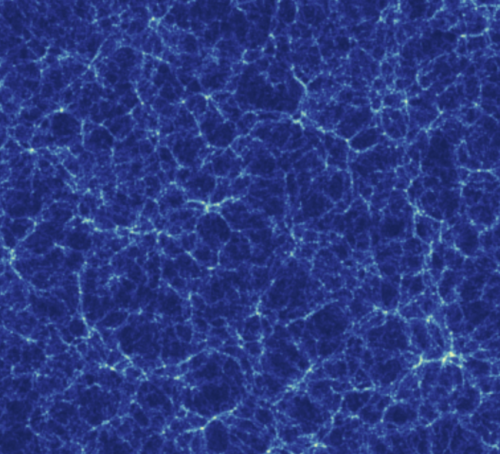July 3, 2014 report
Trio of physicists create computer simulation of dark matter using an empirical function

(Phys.org) —Three physicists affiliated with several universities in the U.S. and France have built a computer simulation of the bubble-like voids that exist in dark matter which offers better density information. In their paper published in the journal Physical Review Letters, the researchers describe how their simulation showed that such voids have a wide range of sizes and ages with highest densities occurring in boundary areas.
Scientists still don't know much about dark matter—it's believed to make up most of the known universe (as evidenced by gravitational studies) and doesn't interact much with parts of the universe we can see, which of course, includes light. To gain a better understanding of it, researchers have been creating computer simulations based on what is observable. Such simulations in the past have shown that dark matter is not uniform, in fact, if we could see it, it would look a lot like the inside of bones—lots of air pockets (voids) with boundary material between them. The simulations indicate that the voids in dark matter form as dark matter akin to a gas, collapses under its own gravity into sheets or filaments that form the boundary between the voids. They also have shown that there appears to be more void, than boundary. Some theories suggest that such structures gave rise to the parts of the universe we are able to see. In this new effort, the research trio has created a new simulation that provides a better perspective on the size and shapes of the voids—focusing specifically on density profiles. Their simulation excluded matter that can be seen but did include dark energy.
The new simulation showed voids of various sizes and shapes as has been seen with other simulations—what was new with this simulation was that the team showed that the average density of dark matter reached its maximum in the walls that formed the borders between the voids. They also found that the spherical densities believed to exist at the center of the voids, applies not only to voids of all shapes and sizes, but to those that existed in earlier cosmic history. Interestingly, the researchers found they could fit the profiles empirically using just two parameters in a single formula.
More information: Universal Density Profile for Cosmic Voids, Phys. Rev. Lett. 112, 251302 – Published 27 June 2014: journals.aps.org/prl/abstract/ … ysRevLett.112.251302 . On Arxiv: arxiv.org/abs/1403.5499
ABSTRACT
We present a simple empirical function for the average density profile of cosmic voids, identified via the watershed technique in ΛCDM N-body simulations. This function is universal across void size and redshift, accurately describing a large radial range of scales around void centers with only two free parameters. In analogy to halo density profiles, these parameters describe the scale radius and the central density of voids. While we initially start with a more general four-parameter model, we find two of its parameters to be redundant, as they follow linear trends with the scale radius in two distinct regimes of the void sample, separated by its compensation scale. Assuming linear theory, we derive an analytic formula for the velocity profile of voids and find an excellent agreement with the numerical data as well. In our companion paper [Sutter et al., arXiv:1309.5087 [Mon. Not. R. Astron. Soc. (to be published)]], the presented density profile is shown to be universal even across tracer type, properly describing voids defined in halo and galaxy distributions of varying sparsity, allowing us to relate various void populations by simple rescalings. This provides a powerful framework to match theory and simulations with observational data, opening up promising perspectives to constrain competing models of cosmology and gravity.
Journal information: Physical Review Letters , arXiv
© 2014 Phys.org





















